The Georgian Peach Basket
by Joseph A.A. Bourque Sr.
Issue No. 291 - July 1997
Dear Reader,
This month I will share a strange little Cambridge basket with you, and I will tell how lucky I was to get it. It's a basket in the Georgian line. Research has led me to opine that it was made from a No. 314 five-ounce sherbet blank. (See Figure 1, 1A, and Figure 2 - -1940 Catalog)
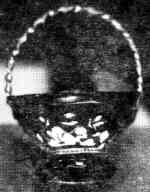
|
|---|
| Figure 1 |
When being made, the moment this item was released from its two-part mold, a flaring tool was applied over the rim to stretch it out until it measured five inches in diameter. Then, as is typical of a basket's shape, two opposite sides were crimped and bent upwards to accommodate a handle. (See Figure 3)
Up to this point, the Georgian-line baskets I have seen, whether real or depicted on paper, all had applied glass handles. This basket is an exception. It has a preassembled ormolu handle having 10 gilded brass parts; one bail, two brackets, one waistband (all nicely decorated), and six rivets. (See Figure 4)
The glass basket container has a full-bodied, dark Carmen coloration. It has some range regarding density, usually referred to as the "gathering effect."
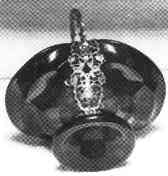
|
|---|
| Figure 1A |
This is the first Georgian basket I have ever seen with a metal handle. it is 2-1/2" high at its tallest glass points, and 6" high to the tip of the ormolu handle
The Georgian design can clearly be seen. The lacy design can also be seen clearly. There is one bracket on both crimped sides of the basket. The base diameter is 2-7/16" in diameter.
(The thicker the glass is in certain areas, the darker it appears.) There are no variations of yellow, which sometimes occur in this red glass.
The basket is well made and is quite symmetrical. The golden ormolu fixture and the deep red glass compliment each other. The lacy brackets and the fine pressed designs on the handle and waist-belt blend in well to give the basket that delicate, artful look. (See Figure 4)
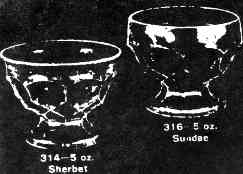
|
|---|
| Figure 2 |
This basket was found in a Group-Shop, but not without that ever important collector's aid, the mini-flashlight. The basket was in a darkened wall-shelf cabinet and at first look it was not perceptible to the eye. The cabinet was locked. It was near closing time. All the clerks were busy checking customers out. As a rule, I carry a mini flashlight with me, but I had left it in the car.
I had inspected the last few booths, but with negative results. At this point, it was closing time. I left the shop with an empty feeling as I had not even seen a good piece of Cambridge all day long. As I was about to start the car I saw my mini-flashlight on the dashboard. I scooped it up and hurriedly I went back to the shop. Luckily, the doors were not yet locked. I proceeded with dispatch to that murky cabinet. The moment the beam of light shone in the dark corner of one shelf, I knew I had my Triangle-C find.
Georgian line items Nos. 314 and 316 were the only items found which had a comparable waistline to the Georgian basket with the ormolu handle with attachments. From both of these items, only the No. 314 has a flared rim identical to the basket. These cutouts are from the 1940 Cambridge Catalog, Page 434.
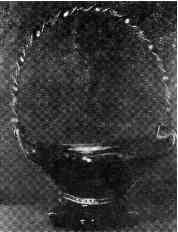
|
|---|
| Figure 3 |
The key-keeper was summoned. I explained my dilemma. She muttered about how late it was, but was sympathetic and opened the cabinet door. Very gently I lifted out this superb little red and golden Cambridge gem. It was in pristine condition, and the price was acceptable.
While I checked the condition of the basket, the clerk said, "It's a peach of a basket." To which I retorted, "Yes, and it's a Georgian peach at that!"
Happy Triangle-C finds.
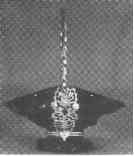 Joe
Joe
Note the upturned and crimped edges of the basket which holds the handle in place. There was another Georgian line "Crimped" basket made by The Cambridge Ohio Glass Company. It was the No. 319/B/3. (See Welker Book 2. Page 37). It is shown at right.
Note the ormolu twisted handle, the bracket with top pinched inside, the waistband, and three rivets; another bracket, one upper rivet, and two other bottom rivets are not shown as they are on the opposite side. The waistband ends are secured together by a spur of one end of the band which engages into a drilled-out hole on the other end of the band. This protruding spur is simply bent down, holding both ends together.
